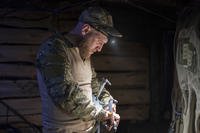 In 2002, Lockheed Martin's Integrated Coast Guard Systems won a contract to stretch and improve as many as 49 Coast Guard patrol boats as part of the service's $24-billion Deepwater modernization effort.
In 2002, Lockheed Martin's Integrated Coast Guard Systems won a contract to stretch and improve as many as 49 Coast Guard patrol boats as part of the service's $24-billion Deepwater modernization effort.
Three years later, with just eight boats re-delivered, the Coast Guard called off the program, citing hull buckling and electronics problems. And it accelerated a new class of patrol boats to fill the gap, with testing beginning in the next couple years.
Something was up ... but nobody outside of the Coast Guard and Lockheed knew just what until former Lockheed engineer Michael DeKort posted a crude video to YouTube, as Defense Tech noted a couple weeks back.
In the video, DeKort alleged serious contractor misconduct on the patrol boat project. The story got some play on network TV, mostly on account of the YouTube angle, but an unsatisfied DeKort approached Defense Tech parent Military.com with detailed information including supporting documents. Read the first of our two-part expose here:
DeKort says the selection of the [Lockheed Martin] Aegis team [to work on the boats] was beginning of the program's problems. Aegis engineers are software experts; the patrol boats required little software work.
"Aegis has nothing to do with most of what we were doing on these boats," DeKort says.
That mismatch resulted in a number of contractor failures stemming from bad management, according to DeKort. He says that, in winning the contract, leaders promised to meet deadlines that were impossible at costs that were optimistically low -- around $8 million per boat. The resulting pressure encouraged corner-cutting, DeKort claims.
He says he observed three serious failures that were not corrected before the first boat re-entered Coast Guard service in March 2004:
1) Project leaders left a blind spot in the boat's security system when they omitted one of five video cameras to save money. When DeKort raised this issue with team leaders, they said the solution was "to lock the window" in the blind spot and periodically "check for broken glass" such as an intruder might leave behind.
2) In installing a new Forward-Looking Infra-Red camera, the team used a cheap cable that wasn't weatherproof, meaning it might fail in rain or high seas, depriving the boat's crew of its "eyes in the dark".
3) Perhaps most seriously, according to DeKort, the team used unshielded cables in the terminals that connect the boats to the military's secure internet. "Any foreign government monitoring these boats, from shore or from 'fishing boats', will be able to pick up all the communications from these boats. Since we have no shielded cables, these boats will emanate like an antenna.
Owing to this program failure and other complications, the Coast Guard has identified a "critical shortfall in patrol boat hours," according to Rear Admiral Gary T. Blore, Deepwaters new program executive officer. The service is scrambling to find solutions. One proposal is to boost operating funds for the two Cyclone-class patrol boats donated by the Navy a few years back.
Tune in next week for part two of my Military.com series, where I take a look at some of the underlying causes of the patrol boat fiasco.
-- David Axe








